Acer Aspire S7 Ultrabook: Acer’s Best Foot Forward
by Jarred Walton on January 7, 2013 4:30 AM EST- Posted in
- Laptops
- Acer
- Intel
- Ivy Bridge
- Aspire S7
- Ultraportable
- Ultrabook
Display Quality
Now we get to the one area where so many laptops fall short: the display. I’m a bit torn on the overall LCD experience, because on the one hand it’s the best LCD I’ve ever seen in an Acer laptop, but on the other hand there’s still room for improvement. Let’s start with the good news first: Acer is using a 1080p IPS touch screen, which means great viewing angles (which are necessary for any tablet-like experience). Contrast and maximum brightness are also good.
So what’s the problem? The problem is that there’s a reddish cast to the display and the color gamut as well as color accuracy—even after calibration—are not as good as we would like. Apple is still the company to beat for out-of-box color accuracy, and area they’ve greatly improved on with their latest devices.
We’ve been talking about LCD quality in mobile devices for over six years, and finally it looks like companies are heading in the right direction, but we want to get there faster. The ideal would be to have every display calibrated at the factory to provide relatively accurate colors, but barring individual calibration of panels, we’d be happy with the general LCD family targeting a 6500K white point with a sub-3.0 average DeltaE on the Gretag MacBeth color chart. That might sound like we’re asking for professional display quality, but let me point out that: 1) it’s now 2013 and professionals have had the tools to do this for over two decades; 2) we’re looking at a minimum $1400 MSRP laptop, so this isn’t a budget-friendly device to begin with.
Most consumers wouldn’t recognize accurate colors in the first place, and sadly when you’re at the store and a salesperson has two displays next to each other in the bright retail lights, many people will prefer the less accurate but brighter colors that the S7 currently delivers. Even without perfect colors, however, the Acer S7’s AU Optronics B133HAN03.0 v1 panel is pleasing to use. Here are the numbers.
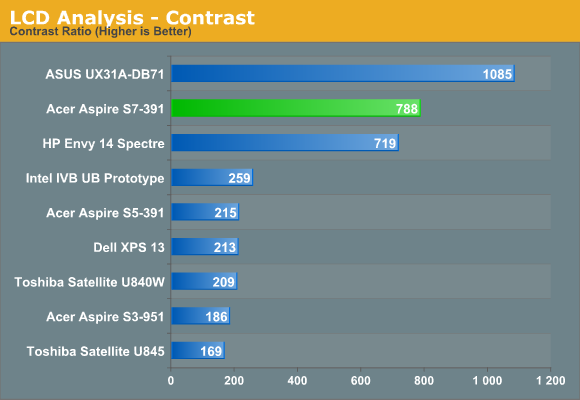
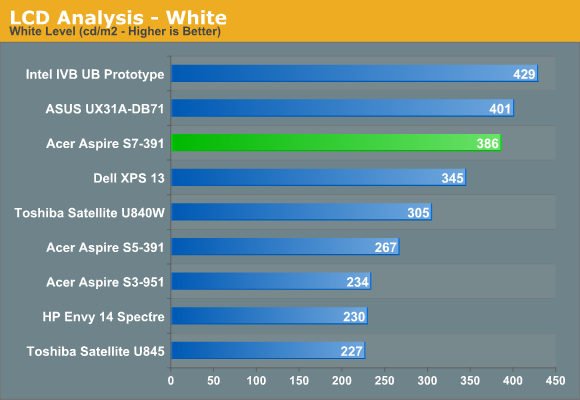
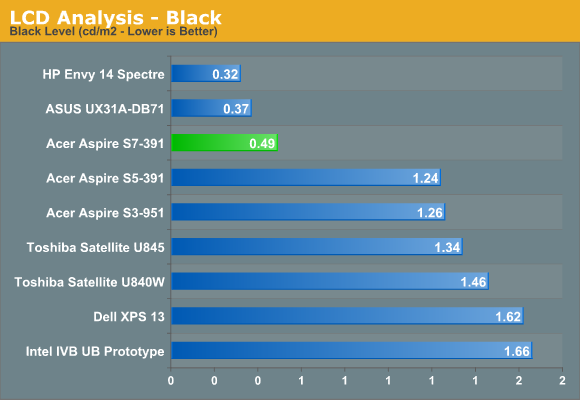
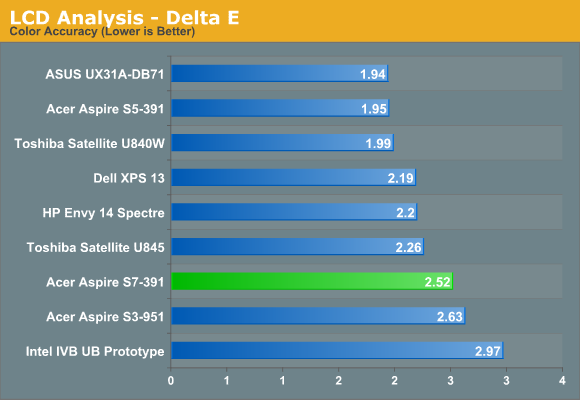
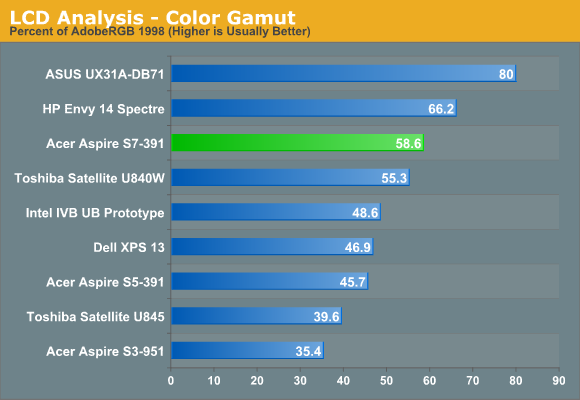
Contrast and brightness are good, though we’ve seen better. As I noted above with the colors being somewhat off before calibration, that carries over post-calibration with an average DeltaE that’s still around 2.5—ideally we’d like to see well under 2.0 for a quality display. The 58.6% color gamut is also less than what we’d like to see, which at a minimum would be the full sRGB color space (around 69%). What’s more, we chose the best calibration result for the above charts; with some of the other targets, the color gamut is a dismal 36%. If you’re okay with the native white point, you get a higher gamut, but if you want to target 6500K or D65, expect to see less than ideal results.










53 Comments
View All Comments
blue_urban_sky - Tuesday, January 8, 2013 - link
Why stop there, make it an even 1" then you could have 2 memory slots and a removable hard drive. Or even better make it 1.5" and have a huge removable battery, an optical drive and a dedicated GPU! No make it 2" and 17" screen then you can have a full sized keyboard top of the range graphics high end CPU tons of storage and neon lights on the top of the shiny plastic case!!1!Not really aimed at you, just all the people who like there £300 lappy and can not possibly imagine a world where other people want different things.
thesavvymage - Tuesday, January 8, 2013 - link
you totally did not comprehend what i meantblue_urban_sky - Wednesday, January 9, 2013 - link
You can't see the point of making the thinest laptop.You think they should have made it fatter and increased the stats.
You justify this by saying people could not tell the difference without a ruler.
You fail to understand that increasing the height from 0.5"->0.7" is a 40% increase in volume where "overall volume are what matters the most" .
rarson - Thursday, January 10, 2013 - link
You completely failed to grasp his point. Making the thinnest laptop possible doesn't make any sense if it adds too much to the price. If it compromises too many variables, then it's obviously more logical to make a slightly thicker device. All you're doing is reconstructing his statements into a straw man. You're also using percentages to make your argument sound stronger, but nobody cares about percentages. We're talking about actual thickness here. You know, real world stuff. Nice try.blue_urban_sky - Friday, January 11, 2013 - link
Joy the straw man miss used again. They were to illustrate that I understood their position thus arguing against "you totally did not comprehend what i meant".Shall we dissect your truism :-
"Making the thinnest laptop possible doesn't make any sense if it adds too much to the price"
Is that too much according to you or is it a standardised figure? So your argument can be read as
"Making the thinnest laptop possible makes sense if it doesn't add too much to the price"
And:-
"If it compromises too many variables, then it's obviously more logical to make a slightly thicker device."
Compromises on variables that you hold above others. So this could be rearranged to
"If it doesn't compromise too many variables, then it's obviously more logical to make a thinner device."
Lastly
"but nobody cares about percentages. We're talking about actual thickness here. You know, real world stuff."
I commend that you went to the trouble of asking everyone (out of interest did you insult them as well?). Ahh I didn't realise we were talking about 'actual' thickness!
You're also using 'actual' to make your argument sound stronger (sry couldn't resist).
The real world works by iterative development things happen in small increments.
rarson - Thursday, January 10, 2013 - link
I'd even argue ergonomics are now more important than overall bulk. Modern laptops just aren't that thick or heavy anymore, so I don't understand why some people are claiming that a pound here or a half-inch there are worth the ridiculous price premium. I also don't understand what a touchscreen has to do with being light and thin, but I digress.I realized how much I appreciate the 15" size when I tried using an 11" netbook for an extended period of time. The keyboard was just far too cramped. 10 inches might be a good size for a tablet, but when I want keys, I'd rather give up some size and thickness for better keys and room for my hands to be comfortable. Having the extra screen space of a slightly larger chassis is a bonus, and coming from an 11" chassis, there's no comparison.
I've got an old PII laptop that until recently I would occasionally use. That thing probably weighs about 9 or 10 pounds. It's nicely built, and even has a matte screen, but it does get heavy to hold. I can't help but think that the 5-and-a-half pound notebook I'm using right now is pretty darn light. It's lighter than the 6-lb bowling ball I used to throw when I was 8. It's also got a bigger screen and a much nicer keyboard than this Acer, and cost about a fourth of the price.
Clearly, these ultrabooks are toys for suckers who think their social status depends on what kind of gadgets they own.
Tech-Curious - Thursday, January 10, 2013 - link
Agreed. Well said.blue_urban_sky - Friday, January 11, 2013 - link
*sigh* You were doing well right up to your last paragraph.B-
dszc - Wednesday, January 9, 2013 - link
Jarred,Thanks for your review. And special extra thanks for emphasizing productivity features and ergonomics for people who actually work.
I am a professional photographer and full-time businessman. I live in Photoshop, Excel, Word, eMail, and web research. That is what I must do and what I enjoy doing. I never play games.
Your comments on the action and utility of the keyboard and its layout are crucial. Also the touchpad. The keyboard and its shortcuts, along with the touchpad is where most true workers live. We can get things done 10x faster with these interfaces than with a touchscreen.
Thank you for continuing to harp on these issues, as they are critical. Yes, a pretty face is nice to look at, but the real beauty of a computer is in its function.
As for price, I am by no means rich, but I am more than willing to pay for an excellent productivity tool. If a laptop must cost $1100 or 1200 or 1300 to have essential features such as a decent IPS panel and a decent backlit keyboard and a decent touchpad, then so be it. But if you take away the backlit keyboard to save $20 or $50 or whatever, then the laptop to me becomes useless.
There are tons of functionally compromised laptops for the masses that are hobbled by pricepoint. But it is not right to reduce those of us who must work for a living to the lowest common denominator.
Kudos to Acer for stepping up with an IPS screen. I would be MORE than willing to pay $1300 for this tool if Acer had bothered to get the little things right - excellent backlit keyboard with great layout; fantastic (rather than mediocre) touchpad; decently calibrated IPS panel. And I'd much rather pay $1400-$1500 to have these things RIGHT, than $1200-$1300 and have them not quite right.
Thanks again, Jarred, for your great reviews.
Thanks, Acer, for moving in the right direction. Please don't stop short of the goal.
bobjones32 - Thursday, January 10, 2013 - link
I'm a huge tech dork as you'd expect considering I'm reading AnandTech. So when my wife decided to get this laptop, I gave her a quick Windows 8 tutorial as if I was teaching an alternate version of myself how to use it."Just click the desktop"
"Just use the trackpad, why use touch?"
"You can mostly ignore the Metro stuff, that's just meant for tablets"
Cut to my surprise when she basically ignores all that advice, and absolutely falls in love with the laptop using touch almost all the time, sticking in Metro apps almost all the time, and barely ever seeing the Desktop.
When the laptop is sitting on a desk, she's always resting on her elbows anyway, so reaching toward the screen is natural. When the laptop is sitting on her lap, her thumbs are right there at the screen, so it's perfectly natural to reach out and touch it. Metro apps meet most of her needs for web browsing, playing games, and chatting with friends, so she really only uses the Desktop for Office.
The keyboard is a bit annoying to her, but everything else about the laptop is nearly perfect. Even the battery life, considering that she's coming from a Vista-era laptop from 5-6 years ago that was upgraded to Windows 7.
After observing her learn to use Windows 8 and eventually fall in love with it and this laptop, it really made me rethink my expectations for the OS in general. Maybe the tech press has it wrong because they're approaching it from expectations that normal people simply don't care about?